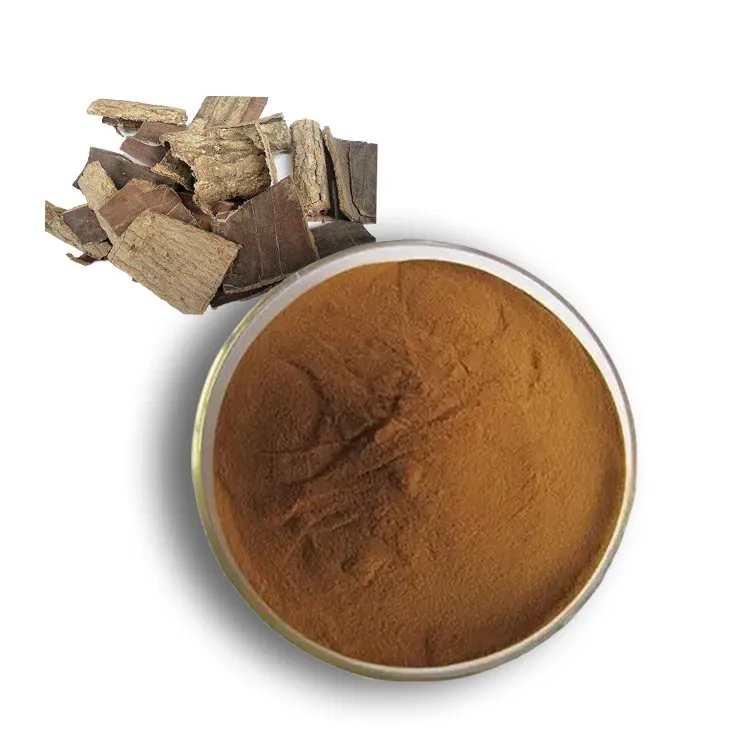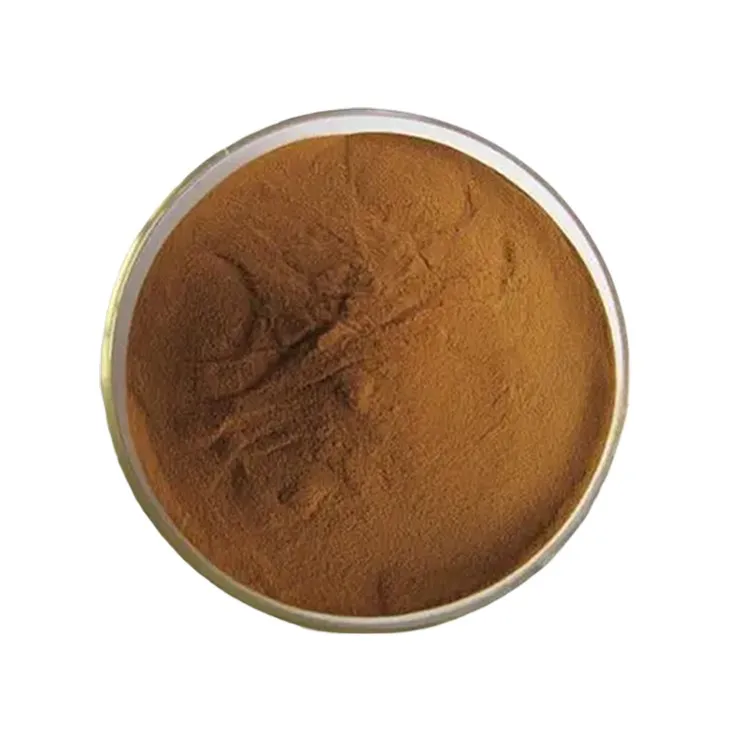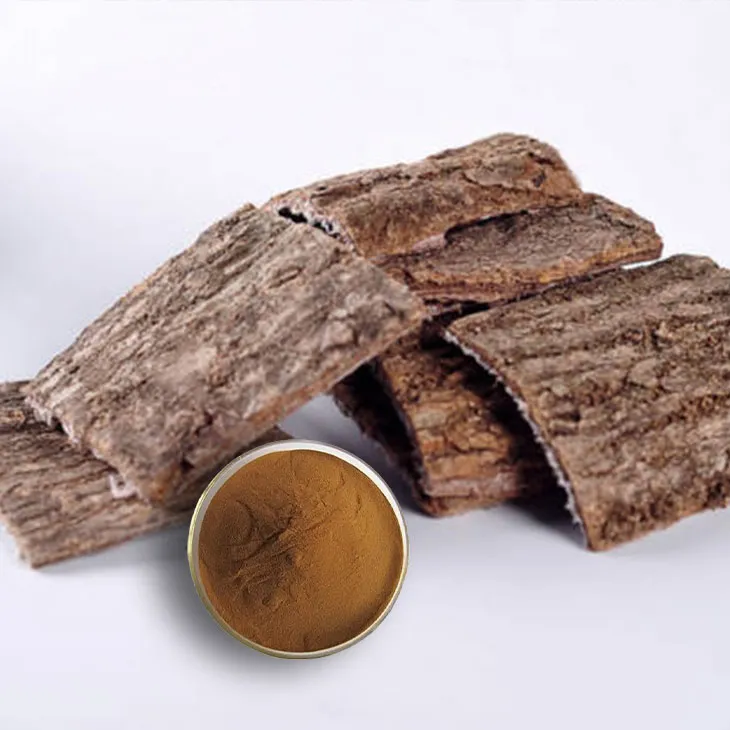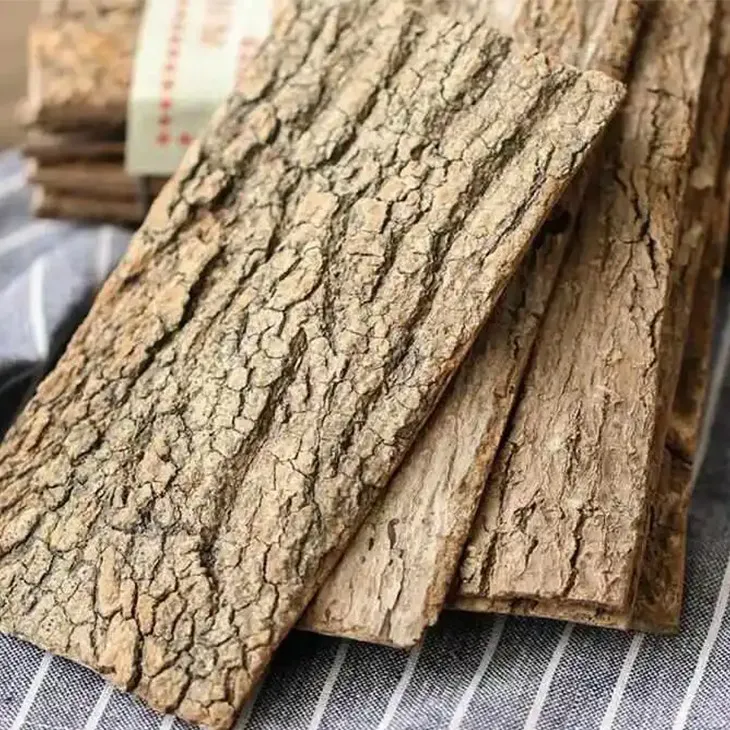- 0086-571-85302990
- sales@greenskybio.com
Eucommia ulmoides Extract: From Leaves to Extraction.
2024-11-12

1. Introduction to Eucommia ulmoides Leaves
Eucommia ulmoides, also known as the hardy rubber tree, is a deciduous tree native to China. Its leaves are of particular interest due to their numerous beneficial properties. Eucommia ulmoides leaves are typically oval - shaped with a smooth margin. They have a distinct green color, which is an indication of their rich chlorophyll content and active photosynthetic processes.
These leaves are a rich source of natural resources. They contain a variety of bioactive compounds, which are the key to their potential applications in different fields. One of the main features of the leaves is their high content of flavonoids. Flavonoids are known for their antioxidant properties, which can help in scavenging free radicals in the body. This antioxidant activity is crucial for maintaining good health and preventing various diseases associated with oxidative stress.
In addition to flavonoids, Eucommia ulmoides leaves also contain other important components such as lignans. Lignans are a class of polyphenolic compounds that have been studied for their potential health - promoting effects. They may play a role in modulating hormonal balance, reducing inflammation, and protecting against certain types of cancer.

2. The Extraction Process
2.1 Selection of Raw Materials
The first step in the extraction of Eucommia Ulmoides Extract is the careful selection of raw materials. High - quality leaves are crucial for obtaining a good - quality extract. Leaves should be harvested at the appropriate time. Generally, it is recommended to harvest the leaves during the growth period when the content of bioactive compounds is at its peak.
After harvesting, the leaves need to be properly dried. Drying helps to preserve the leaves and prevent the degradation of bioactive compounds. There are different drying methods available, such as air drying and low - temperature drying. Air drying is a traditional method, which is simple and cost - effective. However, it may take a longer time and is more susceptible to environmental factors. Low - temperature drying, on the other hand, can better preserve the quality of the leaves but requires more advanced equipment.
2.2 Extraction Techniques
There are several extraction techniques available for obtaining Eucommia Ulmoides Extract. One of the most commonly used methods is solvent extraction. In solvent extraction, a suitable solvent is used to dissolve the bioactive compounds from the leaves. Ethanol is a popular solvent for this purpose due to its relatively low toxicity and good solubility for many bioactive compounds.
The solvent extraction process typically involves soaking the dried leaves in the solvent for a certain period of time. This allows the bioactive compounds to be transferred from the leaves to the solvent. After that, the mixture is filtered to separate the solid residue from the solvent - containing the extract. The solvent is then evaporated to obtain the concentrated extract.
Another extraction technique is supercritical fluid extraction (SFE). Supercritical fluids, such as supercritical carbon dioxide, have unique properties that make them suitable for extraction. They have a high diffusivity and low viscosity, which can penetrate the plant material more effectively and extract the desired compounds more efficiently. SFE is considered a "green" extraction method as it does not leave behind harmful residues and can be more selective in extracting specific compounds.
Microwave - assisted extraction (MAE) is also an emerging technique. In MAE, microwave energy is used to heat the solvent - leaf mixture. This rapid heating can accelerate the extraction process by increasing the mass transfer rate of the bioactive compounds from the leaves to the solvent. MAE has the advantages of short extraction time, high extraction efficiency, and relatively low energy consumption.

3. Chemical Components in Eucommia ulmoides Leaves and Their Extraction
As mentioned earlier, Eucommia ulmoides leaves contain a variety of chemical components. Understanding these components and how they can be extracted is essential for maximizing the potential of the extract.
Flavonoids are a major group of compounds in the leaves. Different flavonoids, such as Quercetin and kaempferol, have different chemical structures and properties. The extraction methods need to be optimized to ensure the efficient extraction of these flavonoids. For example, in solvent extraction, the choice of solvent and extraction conditions (such as temperature, time, and solvent - to - sample ratio) can affect the extraction yield of flavonoids. Ethanol - water mixtures with different ratios are often explored to find the optimal conditions for flavonoid extraction.
Lignans are another important class of compounds. Their extraction can be more challenging due to their complex chemical structures. Supercritical fluid extraction has shown potential in selectively extracting lignans. By adjusting the pressure and temperature of the supercritical fluid, it is possible to target and isolate lignans from the leaves more effectively.
In addition to flavonoids and lignans, there are also other minor components in the leaves, such as alkaloids and terpenoids. These components also contribute to the overall biological activity of the extract. Their extraction and isolation require careful consideration of the extraction techniques and conditions.

4. Potential Applications of Eucommia Ulmoides Extract
4.1 In Medicine
Eucommia ulmoides extract has shown great potential in the field of medicine. The antioxidant properties of the flavonoids and other bioactive compounds in the extract can help in protecting cells from oxidative damage. This may have implications for preventing chronic diseases such as cardiovascular diseases, diabetes, and neurodegenerative disorders.
Some studies have also suggested that the lignans in the extract may have anti - inflammatory effects. Inflammation is a key factor in many diseases, and by reducing inflammation, Eucommia ulmoides extract may contribute to the treatment of inflammatory diseases such as arthritis.
Moreover, the extract may have potential in promoting bone health. There is evidence that certain components in the extract can stimulate osteoblast activity, which is important for bone formation and maintenance.
4.2 In Health Products
In the health products market, Eucommia ulmoides extract is becoming increasingly popular. It can be used as a dietary supplement due to its rich content of bioactive compounds. For example, it can be formulated into capsules or tablets for people who want to improve their overall health or boost their immune system.
The extract can also be added to functional foods. For instance, it can be incorporated into energy bars or drinks to provide additional health benefits. The antioxidant and anti - fatigue properties of the extract can make these products more appealing to consumers.
4.3 In Cosmetics
Eucommia ulmoides extract has found applications in the cosmetics industry as well. The antioxidant and anti - aging properties of the extract make it suitable for use in anti - aging creams and serums. It can help in reducing wrinkles, improving skin elasticity, and protecting the skin from environmental damage.
The anti - inflammatory properties of the extract can also be beneficial for treating skin conditions such as acne and eczema. By reducing inflammation in the skin, the extract can promote skin healing and improve skin complexion.

5. Conclusion
Eucommia ulmoides extract, derived from its leaves, has a wide range of potential applications in medicine, health products, and cosmetics. The extraction process plays a crucial role in obtaining a high - quality extract with a high content of bioactive compounds. Different extraction techniques have their own advantages and can be selected based on specific requirements.
Further research is still needed to fully understand the chemical components of Eucommia ulmoides leaves and their mechanisms of action. This will help in the development of more effective extraction methods and the exploration of new applications for the extract. Overall, Eucommia ulmoides extract represents a promising natural resource with significant potential in modern industries.
FAQ:
What are the unique characteristics of Eucommia ulmoides leaves?
Eucommia ulmoides leaves are known for their unique appearance and certain chemical compositions. They often have a distinct shape and texture. Chemically, they contain various substances such as flavonoids, lignans, etc. These components give the leaves certain properties like antioxidant capabilities, which contribute to their potential uses in different industries.
What are the main extraction techniques for Eucommia ulmoides extract?
There are several common extraction techniques. One is solvent extraction, which uses solvents like ethanol or water to dissolve the desired components from the leaves. Another is supercritical fluid extraction, which utilizes supercritical fluids such as carbon dioxide. This method can often be more selective and can produce high - quality extracts. Additionally, ultrasonic - assisted extraction can also be used, where ultrasonic waves help to break down the cell walls of the leaves, facilitating the extraction of components.
How do different extraction methods affect the chemical components of the extract?
Different extraction methods can have different effects on the chemical components. For example, solvent extraction may extract a wide range of components depending on the polarity of the solvent. Supercritical fluid extraction, being more selective, can target specific components more effectively. In some cases, a more aggressive extraction method might break down certain sensitive components, while a milder method might not be able to fully extract all the desired substances. So, the choice of extraction method needs to be carefully considered based on the target components and their intended applications.
What are the potential applications of Eucommia ulmoides extract in medicine?
In medicine, Eucommia ulmoides extract has shown potential in several areas. It may have anti - inflammatory properties, which could be useful in treating various inflammatory diseases. Some studies suggest it may also have effects on blood pressure regulation, potentially helping in the management of hypertension. Additionally, its antioxidant components might play a role in preventing certain oxidative - stress - related diseases.
How is Eucommia ulmoides extract used in health products?
Eucommia ulmoides extract is used in health products in various ways. It can be added to dietary supplements, often as a source of natural antioxidants or for its potential health - promoting properties. In some functional foods, it may be included to enhance the overall nutritional value or to target specific health benefits such as improving joint health or enhancing the immune system.
Related literature
- Chemical Components and Bioactivities of Eucommia ulmoides Oliv.: A Review"
- "Eucommia ulmoides Extract: New Insights into Its Extraction and Application"
- "Optimization of the Extraction Process of Eucommia ulmoides Leaves for Pharmaceutical Purposes"
- ▶ Hesperidin
- ▶ citrus bioflavonoids
- ▶ plant extract
- ▶ lycopene
- ▶ Diosmin
- ▶ Grape seed extract
- ▶ Sea buckthorn Juice Powder
- ▶ Beetroot powder
- ▶ Hops Extract
- ▶ Artichoke Extract
- ▶ Reishi mushroom extract
- ▶ Astaxanthin
- ▶ Green Tea Extract
- ▶ Curcumin Extract
- ▶ Horse Chestnut Extract
- ▶ Other Problems
- ▶ Boswellia Serrata Extract
- ▶ Resveratrol Extract
- ▶ Marigold Extract
- ▶ Grape Leaf Extract
- ▶ blog3
-
Cranberry Plants and Skin - care Products.
2024-11-12
-
Buckthorn bark extract
2024-11-12
-
Saw Palmetto Extract
2024-11-12
-
Nettle Root Extract
2024-11-12
-
Dandelion Leaf Extract
2024-11-12
-
Scutellaria Extract
2024-11-12
-
Black Rice Extract
2024-11-12
-
Coconut Water Powder
2024-11-12
-
Milk Thistle Extract
2024-11-12
-
Withania Somnifera Extract
2024-11-12
-
Sophora Japonica Flower Extract
2024-11-12





















